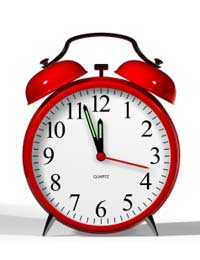How to Tell the Time in Spanish

There are a few key Spanish words and phrases that can make all the difference when visiting or travelling in Spain. This includes knowing how to tell the time in Spanish. Telling the time in Spanish is useful for many reasons. It can be helpful to know how to tell the time when travelling on buses or trains and is very useful when talking with Spanish people.
How to Ask the Time in Spanish
When someone wants to know the time in Spanish they will ask ¿Qué hora es? This means what time is it? If someone is asking when something is happening, they will ask ¿Cuándo ...? To ask what time something is happening the question will start ¿A qué hora...? Note the inverted question mark at the front of the questions. This is important in written Spanish.How to Tell the Hour in Spanish
Telling the hour in Spanish is very straightforward:- It is 1 o’clock - es la una
- It is 2 o'clock - son las dos
- It is 3 o'clock - son las tres
- It is 4 o'clock - son las cuatro
- It is 5 o'clock - son las cinco
- It is 6 o'clock - son las seis
- It is 7 o'clock - son las siete
- It is 8 o'clock - son las ocho
- It is 9 o'clock - son las nueve
- It is 10 o'clock - son las diez
- It is 11 o'clock - son las once
- It is 12 o'clock - son las doce
The Quarter and Half Hours
If the time is quarter past the hour then it is indicated by adding y cuarto, or instance las ocho y cuarto (a quarter past eight) or las cinco y cuarto (a quarter past five). When it is quarter to the hour then the time is indicated by adding menos cuarto, for instance las cinco menos cuarto (quarter to five).The half hour is indicated by adding y media. For instance las tres y media (half past three) or las once y media (half past eleven). It is also perfectly acceptable to use the number of minutes instead of using the words cuarto and media. For instance cinco y quince (fifteen minutes past five) or tres y treinta (thirty minutes past three).
Indicating Precise Minutes
While the ways of telling the time above are suitable for many occasions, there are times when using the precise minutes is necessary. This is particularly the case when travelling. The minutes are added after the hour by using y, for instance las dos y cinco (five minutes past two). When the minutes are before the hour then the time is indicated by using menos (minus), for instance las once menos diez (ten to eleven).The Spanish for numbers between one and thirty are as follows:
- 1 - uno
- 2 - dos
- 3 - tres
- 4 - cuatro
- 5 - cinco
- 6 - seis
- 7 - siete
- 8 - ocho
- 9 - nueve
- 10 - diez
- 11 - once
- 12 - doce
- 13 - trece
- 14 - catorce
- 15 - quince
- 16 - dieciséis
- 17 - diecisiete
- 18 - dieciocho
- 19 - diecinueve
- 20 - veinte
- 21 - veintiuno
- 22 - veintidós
- 23 - veintitrés
- 24 - veinticuatro
- 25 - veinticinco
- 26 - veintiséis
- 27 - veintisiete
- 28 - veintiocho
- 29 - veintinueve
- 30 - treinta
Telling the time and being able to understand when the time is being said are a useful addition to a travellers Spanish vocabulary and can help make a visit to Spain or another Spanish speaking country successful.







